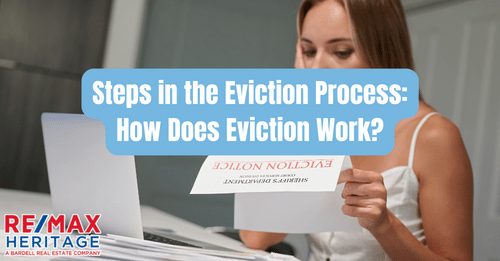How Does Eviction Work?


Going through an eviction isn’t an ideal outcome for landlords or their tenants. Surprisingly though, the eviction process is more common than you think — according to the U.S. Federal Reserve, roughly 3 million non-homeowners were evicted or forced to move due to the threat of eviction between 2016 and 2018.
While some evictions are unavoidable, there are best practices that landlords should follow to rent responsibly and prevent evictions altogether, including properly screening tenants and signing lawyer-approved, state-compliant lease agreements. Here’s what every landlord needs to know about the eviction process.
What Is an Eviction?
People often associate the word “eviction” with the physical act of the tenant being expelled from a rental property. In actuality, an eviction is a lengthy legal process. This process starts with an eviction notice, frequently in the form of a Pay or Quit Notice, and if necessary, culminates in an Unlawful Detainer, which is carried out by local law enforcement.
According to TransUnion, the average eviction-related cost to landlords is approximately $3,500, and an eviction can take as long as three to four weeks to complete. When comparing this cost to the low price of tenant screening, the results speak for themselves — thorough tenant screening is a less expensive and time-saving alternative. Using a lease agreement that’s already been reviewed by lawyers can also ensure both parties are aware of the processes set in place in the case of an eviction.
Before initiating the eviction process, it may be worth discussing options with tenants directly. Finding a solution before going to court may save significant time and money in the long run, and ultimately, most tenants don’t want to be evicted, since a legal eviction will be reported against the tenant for seven years. When possible, it’s in the best interest of both landlords and tenants to come to an agreement together.
What Are the Steps in the Legal Eviction Process?
To help you know how to break a lease as a landlord, we outlined four steps to take that can help make the eviction process go smoothly.
1. Pay or Quit Notice
A Pay or Quit notice is designed to provide tenants with a formal warning that they are in violation of the lease. This will provide the tenant with specific instructions to comply with their lease and advise the number of days allowed before an eviction is brought to court.
As a landlord, it is best to provide a Pay or Quit Notice (sometimes called a Pay or Vacate Notice) by certified mail. This ensures that there is a legal record of the date that notice was provided. It is common practice to post the notice of eviction to the door of the property, but this should only be done in addition to sending the notice by certified mail.
When going through an eviction, it is of the utmost importance to act professionally and to comply with state and federal laws. Before providing an eviction notice, check the laws for your state to confirm the number of days required for notice and confirm there are legal grounds for eviction. If the legal grounds for eviction are met, you can move to the next step of creating a state-specific eviction notice.
2. Eviction Forms and Filing
After a Pay or Quit notice is served, the tenant has a specific number of days to comply with the lease or vacate the property. If the tenant fails to comply within the provided notice period, then an eviction may be filed against the tenant through the courts.
Filing a Forcible Detainer to remove the tenant requires the following forms:
- Eviction complaint: This form starts the eviction case.
- Summons: This informs the tenant about the eviction case.
These forms are to be filed with the court clerk and to be delivered to the tenant through the local sheriff’s office. You can also check the resources provided by the local clerk’s office to see if there are options for filing online.
As a tenant, if you are served with an eviction summons, be sure to follow the instructions for the summons and check the tenant rights for your state. These are designed to help tenants follow the law and provide protection against any unlawful practices by the landlord.
When an eviction is filed through the court, a judge will review the documentation related to the case and issue a ruling. To help prepare for this step, it is best to have a copy of the signed lease, a record of all payments, and a record of any relevant communication between the landlord and the tenant.
Although Avail cannot act as a legal counsel, the platform is designed to help keep landlords and tenants organized with all necessary documentation stored in one place. This includes:
- Applications saved with the legal name, date of birth, and identification of the tenant.
- Legally-binding state leases that have been reviewed by lawyers with time-stamped signatures.
- Online payments recorded with corresponding receipts and late rent notices.
Be sure to prepare for the eviction case by gathering all corresponding documentation for the judge or the jury. After all relevant parties have made their case, a judgment will be issued. This defines the requirements for any money owed, and if applicable, instructions for the expulsion of the tenant.
3. Judgment
The final step in the eviction process is the removal of the tenant and their belongings from the property. Even after an eviction has been awarded to the landlord, harassment or intimidation is absolutely unacceptable and illegal. If the tenant refuses to leave the property voluntarily, then a court order may be brought to local law enforcement to remove the tenant.
Individual states have different requirements for removing a tenant’s personal belongings. Some states require items to be removed through the court process, while other states give landlords free-reign after the property has been vacated. Check your state requirements before removing a tenant’s personal property.
4. Preparing For New Tenants
It’s worth noting that not all evictions are finalized with the court ordering a Forcible Detainer of a tenant. Throughout the court proceedings, the tenant may agree to comply with an alternate order. Examples of these include an Agreed Move-Out and Compliance, Dismissal with Leave to Reinstate, or a Pay-and-Stay Agreement. These options are generally better for both the landlord and the tenant, because they result in the landlord receiving payment and the tenant having the option to stay in the property.
It’s important to note that some circumstances will add additional steps to the eviction process. Legal representation may be useful to understand the requirements of a particular case.
Some circumstances that may affect or lengthen the eviction process are the following:
- Accepting partial or full rent payments will negate the eviction process.
- If the tenant declares bankruptcy, the eviction process is put on hold until bankruptcy proceedings are finalized.
- Once the tenant has moved out, the landlord typically still has to prepare the property for turnover to the next tenants. Depending on any potential damage caused by the evicted tenant, this could take additional time, and sometimes lead to additional lawsuits.
Evictions can be costly, and due to the variables that can affect the length and outcome of the eviction process, it’s always best to avoid evictions in the first place.
How Much Does an Eviction Cost?
There are quite a few costs associated with evicting a tenant, including attorneys fees, court costs, lost rent, turnover costs, and property damages. As mentioned previously, the cost to break a lease is approximately $3,500.
Even if a landlord wins a financial judgement against the tenant, many landlords are still unable to collect payment from those tenants. According to the American Collectors Association, the success rate for debt collection after an eviction is only 17%.
How Long Does an Eviction Take?
Along with the high cost of an eviction, the process can take weeks to complete. An eviction typically takes from three to four weeks to run its course, but is dependent on your state laws, the specific eviction case and other factors.
Renting a Home through RE/MAX Heritage
If you are looking for a home to rent in the Orlando area we are here to help. As a full-service real estate office licensed to conduct long-term rental activity we are capable of meeting all your needs for long-term leasing.
or call us at (863) 424-3209
Ready to make a Move?
Bardell Real Estate are the experts in helping you with your selling, buying or renting needs near Orlando, Florida. Make your Disney area experience a forever memorable one. Call us now to speak to a real estate agent.
[formlift id=”36911″]
